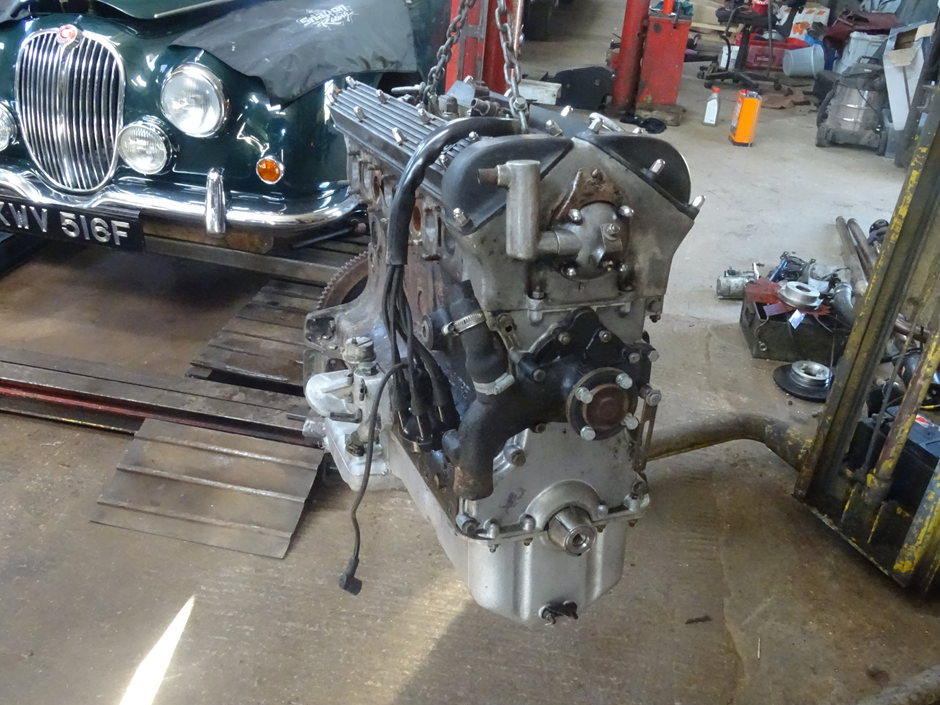Living with the Jaguar XK Engine
By Graeme Spurr
I thought you all might be amused by a short article on the Jaguar XK engine, a somewhat different beast to a lot of members’ classic car engines.
First, a bit of history. The Jaguar XK engine is a twin cam alloy head/cast iron block engine designed in the 1940s. Contrary to the myth that the engine was designed whilst Sir William Lyons (the then head of Jaguar) and William Heynes (the then Jaguar Chief engineer) and others were fire watching during the Coventry blitz, the engine did, in fact, have a more conventional design and development process which started in 1943.
Throughout its production life the engine had various displacements for road going versions, starting with a 2.4 litre (used in the “bank manager’s special” of the MK2 and in the 240), a 2.8 litre (an option for XJs from 1968 to 1974), a 3.4 litre, a 3.8 litre and a 4.2 litre. A special 3 litre version was developed, but only used in motorsport.
The engine was first used in 1948 in the ground breaking Jaguar XK 120 and ceased production in 1992, last being used in 4.2 litre format in the Daimler DS 420 limousine. During this period the engine was used in just about every road car produced by Jaguar and used in Scorpion Tanks, Scimitar armoured reconnaissance vehicles and in a Dennis fire engine. Unlike some sports car engines produced in this era, the engine was not used in any agricultural machinery!
During the remarkable production run of 44 years, it’s true to say that changes were made to the engine. Six different cylinder heads were developed and used (changes to porting, vale angles, valve sizes and so on), block castings changed and of course, various carburettors and fuel injection systems were used.
So, what’s it like to live with such an illustrious engine?
I’ve been lucky enough to have owned two cars which used the engine. First was a Jaguar mk2 2.4 automatic (my first classic car) and secondly my current Jaguar 340 with (obviously) a 3.4 litre engine.
The first thing one realises is that the engines produce a lot of under bonnet heat. Not so bad in the winter, but in the summer….
For some reason Jaguar could not get airflow through its engine compartments properly figured out until the XJ series came along and even then it wasn’t properly sorted out in the XJC, which produced so much under bonnet heat that it had a special cooling system to prevent the battery from overheating!
The engines are renowned for oil leaks, they all leak engine oil. Indeed it was rumoured that this was a design attribute as it formed Jaguar’s answer to underbody rust protection! The truth is that the engine has poor front and back oil seals, both in the sense of materials used and in their design. There’s not a lot one can do about it, the seals can be replaced with modern materials, but eventually they start to loose oil again. Until oil loss gets too bad, it’s best to grin and bear it as to replace the seals means the engine coming out (more of this below).
The other main problem that I have encountered is dropping oil pressure. The books all say that oil pressure should not be below 40psi at normal running speeds, when the engine is at normal running temperature. However oil pumps don’t last forever and the combination of heat and a pump which is starting to fail means that on longer runs oil pressure can’t be maintained.
The aluminium head in my 340 seems to be a bit soft as I am now on my second Heli Coil plug port.
Apart from those points I have not encountered any other problems with the engine.
So what prompts this article? I haven’t used the car much during lockdown and as a result the engine oil leaks got much worse due to the seals drying out. When I moved the car, the amount of oil in the catch pan and on the garage floor was more than expected.
So, I booked the car in with my spanners wizard Paul Furr (of Century Classics Lambourn Woodlands). What Paul doesn’t know about classic cars isn’t worth knowing. Last time I was in his shop, he was rebuilding two bubble cars, as well as working on a series one Landrover and two other Jaguar MK2s. I could go on and on about Paul, his knowledge and the help he has been to me over the years, but I won’t!
The car is now with him having the offending seals replaced, along with new main bearing shells being fitted (thankfully the crank didn’t need to be reground), a new oil pump and, as a precaution, new core plugs fitted.
The easiest way to get and engine out of a MK2 is to drop the front subframe and take it and the gearbox out from underneath. As everything has to come out, I’ve also asked Paul to put a new clutch in it and re-bush the front suspension.
Hopefully I’ll have the car back in about six weeks, in time for Drive It Day. Who knows, perhaps we will be able to have a Club event then!
Keep Safe.
All Rights Reserved | White Horse Classic Vehicle Enthusiasts.




